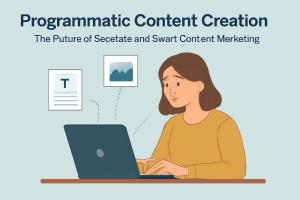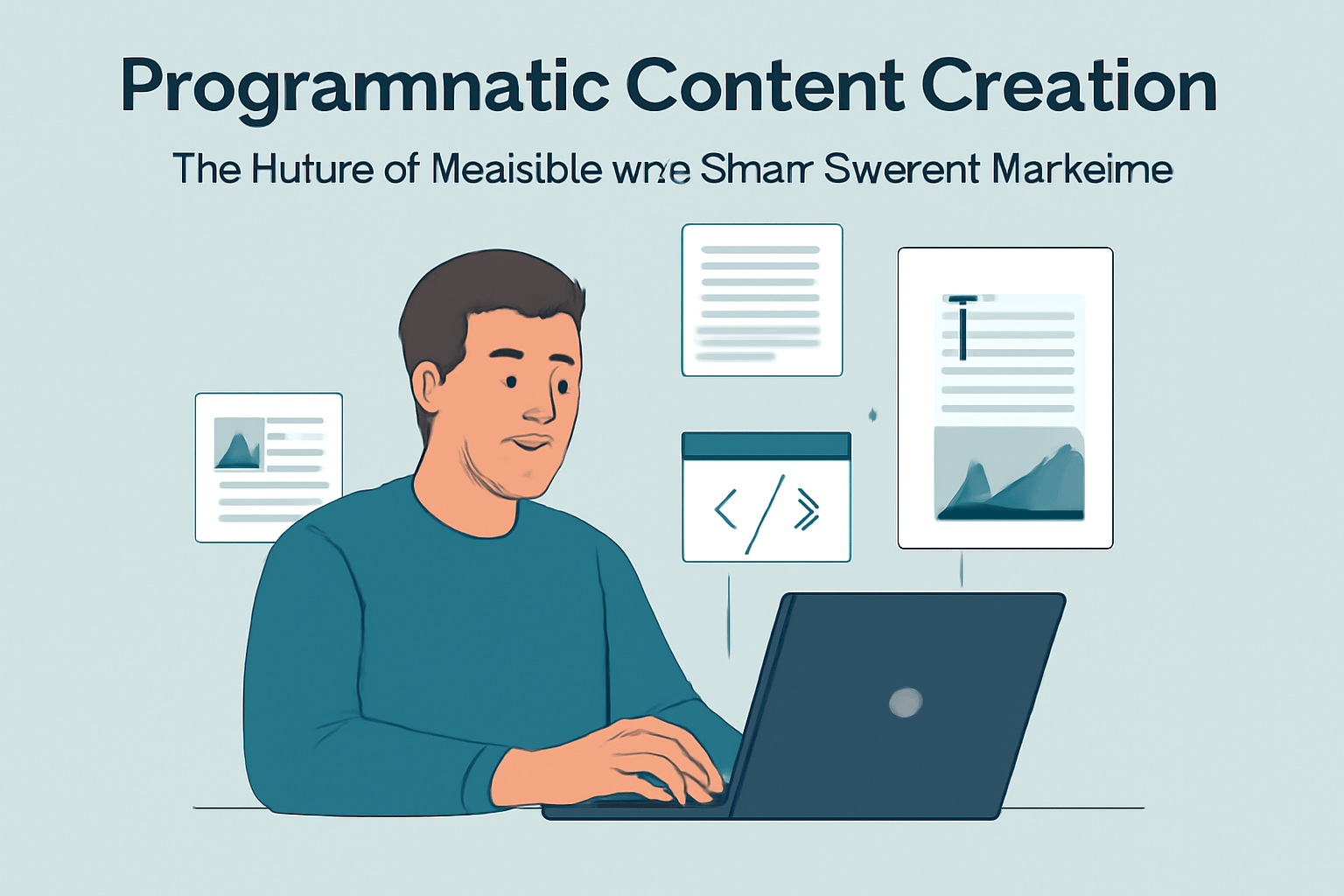Programmatic Content Creation: The Future of Scalable and Smart Content Marketing
In the fast-evolving world of digital marketing, Content is still king. However, the sheer demand for high-quality, SEO-optimized Content across websites, platforms, and industries has made manual content creation time-consuming and costly. Enter Programmatic Content Creation — a revolutionary approach that combines automation, data, and artificial intelligence to deliver content at scale.
Whether you’re a startup trying to build organic traffic, a large enterprise aiming to dominate search engines, or a marketer looking to maximize efficiency, Programmatic Content creation is a productive and effective solution. This guide will explore what it is, how it works, real-world applications, the tools involved, benefits, and challenges.

What Is Programmatic Content Creation?
Programmatic Content creation refers to the automated generation of content using predefined templates, structured data, and sometimes AI-based natural language processing. It enables businesses to produce hundreds or thousands of unique, targeted content pieces quickly, without manually writing each page.
Unlike traditional content creation, which heavily relies on human writers, programmatic content creation uses systems and algorithms to generate content automatically from databases, APIs, or spreadsheets.
Key Components Include:
| Component | Description |
|---|---|
| Templates | Reusable content structures (e.g., blog posts, product pages). |
| Data | Structured inputs such as locations, product specs, or service details. |
| Logic & Rules | Conditional formatting, keyword targeting, and personalization triggers. |
| Automation | Tools or scripts that populate templates from data sources. |
The Rise of Programmatic Content in the Digital Age
With increasing competition in the digital space and a growing demand for SEO content, brands are turning to programmatic strategies to fill content gaps, particularly in areas like local SEO, product pages, and long-tail keyword targeting.
Search engines now reward relevance, topical authority, and breadth of coverage. As a result, creating thousands of pages targeting different varieties of search intent has become a winning strategy—one that is virtually impossible without automation.
Benefits of Programmatic Content Creation
-
- Scalability
Manually writing content for 10,000 cities or product SKUs is impractical. Programmatic content creation makes this not only possible but also efficient.
-
- Time Efficiency
Instead of spending weeks creating content, you can generate thousands of pages in hours once your templates and data are in place.
-
- Cost-Effective
Reduces the need for a large team of writers. Once your automation workflow is set up, ongoing content costs drop significantly.
-
- Consistency
Templates ensure that the format and brand tone are consistent across all content pieces.
-
- SEO Friendly
You can target long-tail keywords with precise content, improving your site’s visibility on search engines.
Real-World Examples of Programmatic Content Creation
-
- TripAdvisor
TripAdvisor uses programmatic content to create landing pages for millions of hotels, accommodations, and experiences, combining customer data and templated language.
-
- Zapier
Zapier’s “App Integration” pages are created programmatically, focusing on integrations like “Connect Google Sheets to Slack,” each following a consistent, SEO-optimized structure.
-
- Airbnb
Airbnb builds programmatic pages for cities and neighborhoods, pulling data from property listings and customer reviews.
-
- Yelp
Yelp creates city-based service listings using data to populate similar templates for restaurants, shops, and local businesses.
How Programmatic Content Creation Works
Step 1: Data Collection
Gather structured data relevant to your content objectives. This may include:
- Product attributes
- Geographic locations
- Business listings
- Service variations
- FAQs and reviews
Sources can include:
- Internal databases
- APIs
- CSV/Excel files
- Web scraping (where legally permitted)
Step 2: Template Design
Templates form the backbone of your programmatic strategy. They include placeholders for variables pulled from your dataset.
Example Template:
Top {{Benefit}} Suppliers in {{City}}
Looking for dependable {{Benefit}} in {{City}}? We've compiled a list of the best-reviewed businesses that offer high-quality {{Benefit}} solutions to meet your needs.
Templates can be written in:
- HTML for web publishing
- Markdown for blogs
- JSON for APIs
Step 3: Content Logic and Personalization
Incorporate logic into your template:
- Conditional formatting (e.g., “if rating > 4.5, say ‘top-rated'”)
- Insert dynamic keywords
- Vary the tone or format for different categories
This reduces redundancy and enhances user experience.
Step 4: Automation
Use automation tools or custom scripts to merge your template with data. This can be done using:
- Python scripts (e.g., with Jinja2 for templating)
- Content management systems (WordPress, Webflow)
- Low-code tools (Zapier, Integromat/Make)
- Custom-built content engines
Step 5: Audit & Quality Control
While automation handles scale, human audit ensures quality. Spot-check for:
- Broken syntax
- Factual errors
- Duplicate content
- Readability and tone
You can also use AI tools to clean duplicates and improve natural language flow.
SEO Best Practices for Programmatic Content Creation
-
- Unique Meta Tags
Ensure each page has a unique title tag and meta description. These should dynamically reflect the page’s keyword and content focus.
-
- Canonical Tags
Avoid duplicate content issues by specifying canonical URLs for similar pages.
-
- Schema Markup
Use structured data to enhance visibility in search results with rich snippets like reviews, FAQs, and more.
-
- Internal Linking
Programmatically embed internal links to relevant categories, blog posts, or services to boost SEO and user navigation.
-
- Mobile Optimization
Ensure your templates are responsive and mobile-friendly for Google’s mobile-first indexing.
Tools for Programmatic Content Creation
Here are some popular tools and platforms:
Data Management:
- Airtable – A user-friendly and powerful spreadsheet-database hybrid.
- Google Sheets – Great for small datasets and collaboration.
- SQL – Perfect for large and complex data sources.
Automation:
- Zapier – No-code automation workflows.
- Make.com (Integromat) – More advanced data manipulation.
- Python – Flexible for custom solutions with libraries like Pandas and Jinja2.
CMS Integration:
- Webflow CMS – Design-first CMS for visual page generation.
- WordPress – Utilize custom post types and plugins (e.g., WP All Import).
- Contentful – A headless CMS for structured content publishing.
SEO Tools:
- Surfer SEO – Optimize content templates based on SERP analysis.
- Screaming Frog – For site-wide audits of programmatically generated content.
- Clearscope – Enhance relevance and keyword optimization.
Challenges of Programmatic Content Creation
-
- Lean Content Risk
If templates are too generic or data lacks depth, content may be seen as low-value or spammy by search engines. Solution: Add engaging intros, summaries, or insights per page, using AI-generated variations.
-
- Duplicate Content
Pages that are too similar may be penalized by Google. Solution: Introduce randomness and semantic variety in templates and content structure.
-
- Technical Complexity
Setting up databases, templates, and automation requires technical expertise. Solution: Start small or use low-code platforms before scaling.
-
- Brand Voice and Quality
Automated content may lack personality or tone consistency. Solution: Use AI tools like ChatGPT to post-process generated content for natural flow.
AI + Programmatic Content: A Powerful Duo
AI is now supercharging Programmatic Content creation, enabling:
- Natural language generation (NLG) from datasets
- Tone and sentiment adjustments
- On-demand summaries, intros, and FAQs
- Voice-friendly content optimization
By combining structured data and AI, brands can create content that is not only scalable but also highly relevant and human-like.
Use Cases Across Industries
E-commerce:
- Product comparison pages
- Buyer guides based on price, range, or specifications
Local Services:
- “Best [Service] in [Location]” pages
- Service zone pages for franchises
Job Boards:
- Role-specific pages by location
- Company job postings with dynamic updates
Real Estate:
- Property listings by city or zip code
- “Homes for sale below $X in [City]”
Travel:
- Destination guides
- Activity postings by location and type
Future Trends in Programmatic Content Creation
-
- Hyper-Personalization
Using behavioral data and AI to tailor Programmatic Content to individual user profiles.
-
- Voice Search Optimization
Generating content optimized for voice queries (e.g., questions, how-tos, short answers).
-
- Multilingual Content at Scale
Translating templates and datasets to deliver localized content across languages.
-
- Visual + Content Automation
Dynamic image and video generation to complement content (e.g., auto-generated thumbnails, infographics).
-
- Content + UX Integration
Dynamic page templates that adjust based on the user’s intent and behavior.
Final Thoughts
Programmatic Content creation is transforming how businesses scale their content marketing efforts. With the right strategy, tools, and data, it’s possible to create SEO-rich, user-focused, and high-performing content at a pace that manual methods can’t match.
While the approach requires careful planning and quality control, the return on investment is significant, from boosting organic traffic to improving conversion rates. As AI and automation continue to evolve, Programmatic Content creation will become more accessible and effective for businesses of all sizes.
Now is the time to embrace this approach — and gain a competitive edge in content generation that aligns with both search engine expectations and user demands.
